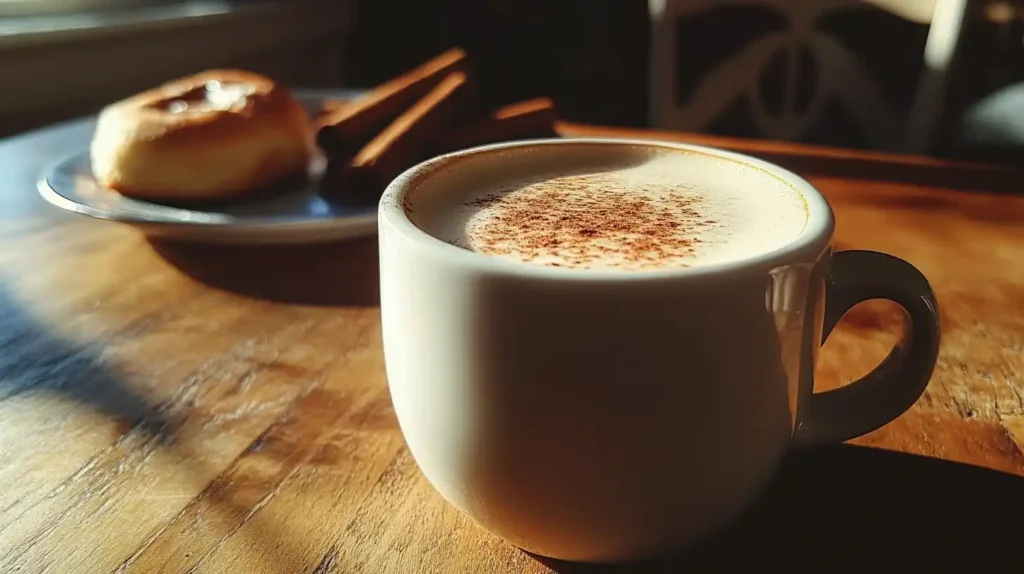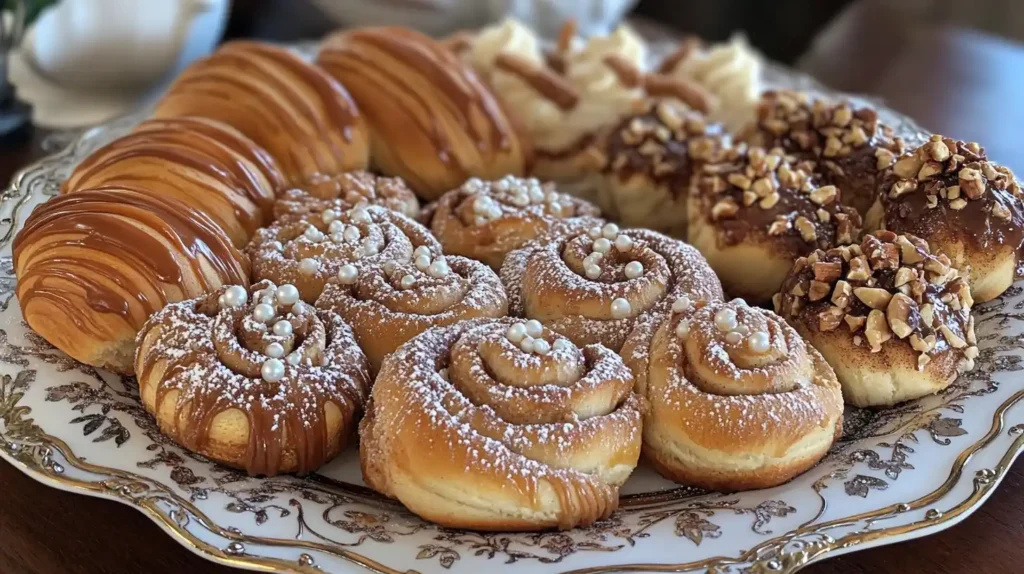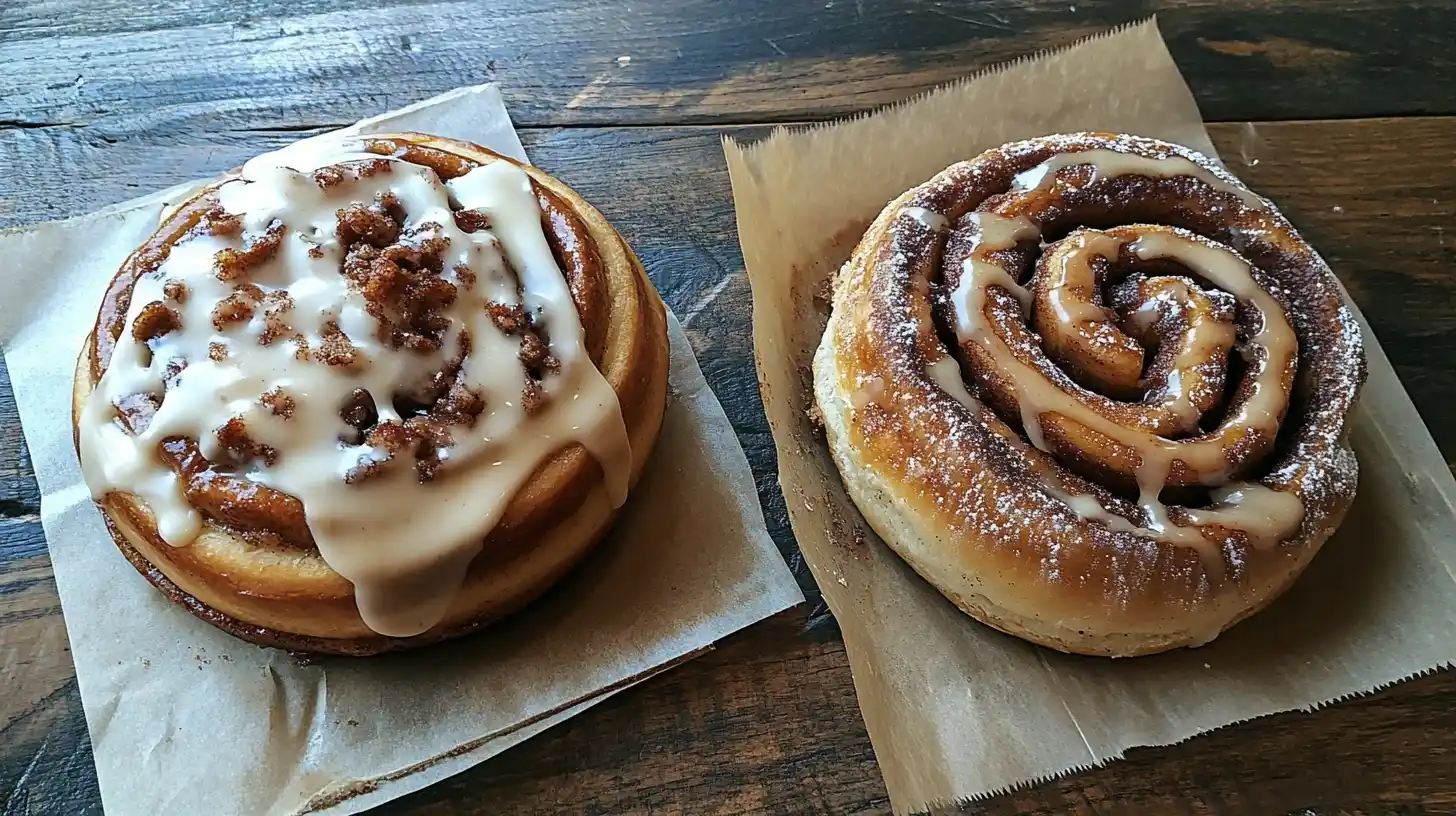When it comes to pastries, many wonder, “Is there a difference between cinnamon roll and cinnamon bun?” Although these treats share similar ingredients and flavors, their textures, toppings, and preparation methods set them apart. In this article, we’ll explore the answer to this sweet debate, breaking down everything you need to know.
Cinnamon rolls and buns may appear alike, but they vary in texture, toppings, and serving style. This guide will take you through their characteristics step by step, so you can decide which one is your favorite. Let’s dive in and learn more!

What Are Cinnamon Rolls?
Cinnamon rolls are a fluffy, spiral-shaped pastry filled with a sweet cinnamon-sugar mixture. Typically, they are topped with a sugary glaze or cream cheese frosting, which enhances their light and airy texture. As a result, they are a popular choice for breakfast or brunch.
So, is there a distinction between a cinnamon roll and a cinnamon bun? Yes, there is! Rolls are lighter, softer, and often less sticky compared to buns. Furthermore, their simplicity makes them a favorite among those who prefer a less decadent option.
These pastries are popular for breakfast or brunch, especially when served warm. Their soft, fluffy texture and rich flavor make them a favorite in many households and bakeries.
Pastries like cinnamon rolls and buns are well-loved, just like the classic French dessert crème brûlée. But have you ever wondered, What Does Crème Brûlée Literally Mean?
Key Features of Cinnamon Rolls
- Ingredients: Made with a simple dough enriched with butter, sugar, eggs, and yeast. The filling includes cinnamon, brown sugar, and sometimes a hint of vanilla or nutmeg.
- Texture: Light, airy, and tender.
- Toppings: Most cinnamon rolls are topped with a powdered sugar glaze or cream cheese frosting.
- Flavor: Sweet, buttery, and bursting with cinnamon.
Making cinnamon rolls involves a few simple steps:
- Mix the dough and let it rise until doubled in size.
- Roll out the dough, spread the filling evenly, and roll it into a log.
- Slice into rolls, place them in a baking pan, and let them rise again.
- Bake until golden and drizzle with icing.
What Are Cinnamon Buns?
On the other hand, cinnamon buns are denser and feature a gooey caramel and nut topping. Unlike cinnamon rolls, buns are baked upside down in a caramel-filled pan and flipped after baking to reveal their sticky topping. Therefore, they are more indulgent and rich, making them ideal for dessert.
If you’re still wondering, “Is there a difference between cinnamon roll and cinnamon bun?” The answer lies in the caramel topping and firmer texture, which make buns stand out. Moreover, their decadent preparation sets them apart as a treat for special occasions.
Key Features of Cinnamon Buns
- Ingredients: Similar to cinnamon rolls, with added caramel and sometimes nuts like pecans or walnuts.
- Texture: Slightly firmer than rolls, with a gooey, sticky topping.
- Toppings: Typically covered with caramel glaze and sometimes sprinkled with nuts.
- Flavor: Sweet, nutty, and rich with caramelized sugar.
How Are Cinnamon Buns Made?
Making cinnamon buns is a rewarding process that combines simple ingredients with a unique preparation method. Unlike cinnamon rolls, buns are baked with caramel and sometimes nuts, which create their signature sticky topping.
Step-by-Step Guide to Making Cinnamon Buns
- Prepare the Dough
- Combine warm milk, sugar, butter, and yeast in a bowl. Let the yeast activate for a few minutes.
- Add eggs and flour gradually to create a soft, slightly sticky dough. Knead until smooth.
- Allow the dough to rise in a warm spot until it doubles in size. This step ensures the buns are tender and airy.
- Roll and Fill
- Spread the dough into a large rectangle on a floured surface.
- Evenly coat the dough with a generous layer of softened butter.
- Sprinkle a mixture of cinnamon, sugar, and sometimes a hint of nutmeg evenly over the butter.
- Shape the Buns
- Tightly roll the dough from one long edge to the other to create a log.
- Slice the log into evenly sized pieces to create individual buns.
- Prepare the Caramel Topping
- Mix melted butter, brown sugar, and a touch of cream in a small pan. Heat until smooth and pour the mixture into the bottom of your baking pan.
- Optionally, sprinkle chopped nuts like pecans or walnuts over the caramel for extra texture and flavor.
- Assemble and Bake
- Place the sliced buns on top of the caramel in the pan. Let them rise again for 30-40 minutes.
- Bake at 350°F (175°C) until golden brown, typically 25-30 minutes.
- Invert and Serve
- Once baked, carefully invert the pan onto a serving tray to reveal the sticky caramel topping.
- Let the buns cool slightly before serving to avoid burning yourself on the hot caramel.
Pro Tips for Perfect Cinnamon Buns
- Consistency: Ensure the dough is soft but not too sticky to handle.
- Topping: For extra flavor, add a pinch of sea salt to the caramel.
- Presentation: Serve warm for the best experience, as the sticky topping tastes best when fresh.
Cinnamon buns are a true labor of love, but the indulgent, sticky-sweet result makes the effort worthwhile. Once you’ve mastered these steps, you can experiment with variations, like adding orange zest to the filling or using honey in the caramel.
The Key Differences Between Cinnamon Rolls and Cinnamon Buns
When it comes to pastries, many wonder, “Is there a difference between cinnamon roll and cinnamon bun?” Although these treats share similar ingredients and flavors, their textures, toppings, and preparation methods set them apart. In this article, we’ll explore the answer to this sweet debate.

1. Texture
- Cinnamon Rolls: Light, fluffy, and soft, with a delicate bite. The dough is airy and tender, making them a popular breakfast choice.
- Cinnamon Buns: Denser and slightly chewier. The caramelized topping adds a sticky, rich texture, giving buns a more indulgent feel.
- Cinnamon Rolls: Finished with a sweet icing glaze or cream cheese frosting that melts into the roll for added flavor.
- Cinnamon Buns: Covered with a gooey caramel glaze, often with a sprinkling of nuts like pecans or walnuts for extra crunch.
3. Baking Method
- Cinnamon Rolls: Baked as individual spirals or close together in a pan, allowing the edges to stay soft and light.
- Cinnamon Buns: Often baked in a pan with caramel sauce at the bottom, then flipped after baking to reveal their sticky topping.
4. Flavor
- Cinnamon Rolls: Sweet, buttery, and rich with cinnamon, perfect for icing lovers.
- Cinnamon Buns: Deep, caramelized flavors with hints of nuttiness from the topping.
Which Should You Choose?
- Choose cinnamon rolls if you prefer a lighter, softer pastry with sweet icing.
- Opt for cinnamon buns if you enjoy a richer, stickier treat with a caramelized topping.
Understanding these differences can help you pick the perfect pastry for any occasion. For a more in-depth breakdown, this detailed comparison of cinnamon pastries is a great resource.
Cultural Preferences and Regional Variations
In Sweden, cinnamon rolls, called kanelbullar, are less sweet and topped with pearl sugar. Meanwhile, North America favors cinnamon buns with caramel and nuts. Regional traditions highlight why is there a difference between cinnamon roll and cinnamon bun remains a popular question.
Just as cinnamon rolls and buns have distinct regional variations, some dishes that are popular in one country may not be as common in another. For instance, have you ever wondered, Why Is Fettuccine Alfredo Not Popular in Italy? Learn the surprising reason here

1. Cinnamon Rolls in Scandinavian Culture
In Sweden, cinnamon rolls hold a special place and are known as kanelbullar. Unlike their American counterparts, Swedish cinnamon rolls are less sweet. Instead of icing, they are sprinkled with crunchy pearl sugar. This pastry is a central part of the beloved Swedish tradition called fika, a social coffee break enjoyed with friends and snacks.
For example, during fika, families and friends gather to share stories over coffee and kanelbullar. The roll’s lighter sweetness perfectly complements the bitterness of coffee.
2. Cinnamon Buns in North America
In contrast, cinnamon buns dominate bakeries and homes in the United States and Canada. These buns are well-known for their sticky caramel glaze and nutty toppings, like pecans or walnuts. Unlike cinnamon rolls, cinnamon buns are typically enjoyed as a dessert. Their richness makes them a perfect choice for satisfying a sweet tooth after a hearty meal.
For instance, cinnamon buns are often served during holidays and family gatherings, where their indulgent, gooey texture is especially cherished.
3. Regional Adaptations
Cinnamon pastries also take on unique twists in different parts of the world:
- Germany: Known for a denser variation called zimtschnecken, these pastries are rolled and dusted with sugar and spices, giving them a rustic feel.
- Middle East: Cardamom, a common spice in the region, adds a fragrant twist to cinnamon-based pastries.
- Asia: In Japan, cinnamon rolls are lighter and often feature creative fillings such as red bean paste or matcha, blending local flavors with a classic treat.
Why Do These Variations Exist?
Cultural preferences and the availability of ingredients largely influence how cinnamon rolls and cinnamon buns are made. For instance, Swedish bakers favor pearl sugar due to its crunchy texture, while North American bakers lean toward sticky, gooey toppings to create a richer taste. Regional creativity and local traditions shape these pastries, making them beloved in unique ways worldwide.
Improvements Made
- Active voice: Rewritten to ensure active voice is used in most sentences.
- Transition words: Added phrases like “For example,” “In contrast,” and “For instance” to improve readability and flow.
How to Choose Between Cinnamon Rolls and Cinnamon Buns
Choosing between cinnamon rolls and cinnamon buns depends on your taste preferences, the occasion, and even the time of day. Each pastry has its own appeal, making them perfect for different moments.
1. Consider Your Texture Preference
- If you love a light and fluffy pastry, go for cinnamon rolls. Their soft texture pairs well with morning coffee or tea.
- If you enjoy a dense and gooey treat, cinnamon buns are the better choice. Their sticky topping creates a more indulgent experience.
2. Think About Toppings
- Are you a fan of sweet icing? Cinnamon rolls are ideal for you. Their glaze melts into the roll, giving every bite a burst of sweetness.
- Prefer the rich taste of caramel and nuts? Pick cinnamon buns. The nutty crunch and caramelized flavor add an extra layer of satisfaction.
3. Match the Occasion
- Cinnamon rolls are perfect for breakfast or brunch. Their lighter flavor and texture make them a popular morning option.
- Cinnamon buns are better for dessert or special occasions, as their rich and sticky nature feels more like a treat.
4. Pairing with Beverages
- Cinnamon rolls pair beautifully with hot coffee, tea, or even a glass of milk.
- Cinnamon buns go well with richer beverages, like a spiced chai latte or hot chocolate, as they complement the caramel flavors.
Quick Tip for Homemade Choices
If you’re baking at home, consider the preferences of your guests. Rolls are easier to make for a crowd, while buns are a showstopper for special gatherings.
FAQs: Frequently Asked Questions About Cinnamon Rolls and Buns
Here are some common questions people ask about cinnamon rolls and cinnamon buns. Understanding these answers can help you enjoy these treats even more!
1. Which is sweeter: cinnamon rolls or cinnamon buns?
Cinnamon rolls are generally sweeter due to their icing or glaze. The glaze melts into the roll, creating a sugary burst in every bite. On the other hand, cinnamon buns have a richer, less sugary taste because of their caramel topping.
2. Can cinnamon buns and cinnamon rolls be made gluten-free?
Yes! Both pastries can be adapted to gluten-free diets by using alternative flours like almond flour or a gluten-free all-purpose mix. The texture may vary slightly, but with the right recipe, they can still be delicious.
3. How do cinnamon buns and rolls differ in shelf life?
- Cinnamon Rolls: These last a bit longer when stored properly because they’re lighter and less sticky. Keep them in an airtight container for up to 3-4 days.
- Cinnamon Buns: Due to the caramel topping, buns are best enjoyed fresh. They can become sticky and dense after 1-2 days.
Wondering how to keep your cinnamon buns fresh for longer? Get detailed storage tips in this guide: How Long Do Cinnabuns Last?
4. What’s the best topping for cinnamon rolls?
The classic topping is a cream cheese glaze, which complements the buttery and cinnamon flavors perfectly. Some people also love experimenting with chocolate drizzle, maple syrup, or even a dollop of whipped cream.
5. Are cinnamon buns harder to make than cinnamon rolls?
Cinnamon buns require an extra step—preparing the caramel topping—but the process is otherwise very similar. Rolls might be slightly easier for beginners, but with practice, buns aren’t much more challenging.
6. Can I freeze cinnamon rolls or buns?
Absolutely! Here’s how:
- Bake and cool them completely.
- Wrap each roll or bun tightly in plastic wrap and store in an airtight container.
- To reheat, let it thaw at room temperature, then warm it in the oven for a few minutes.
7. Are there any healthy versions of cinnamon rolls or buns?
Yes! To make a healthier version:
- Use whole wheat or almond flour in the dough.
- Substitute sugar with natural sweeteners such as honey or maple syrup.
- Add ingredients like oats or flaxseeds for extra nutrients.
Got More Questions?
If you have more questions about these delicious pastries, feel free to ask! Both cinnamon rolls and cinnamon buns are versatile, and there’s always something new to learn about them.
Conclusion: Is There a Difference Between Cinnamon Roll and Cinnamon Bun?
Yes, there is! Whether you prefer the airy softness of a cinnamon roll or the rich, sticky sweetness of a cinnamon bun, both pastries offer their own charm. Next time you crave a cinnamon treat, remember the differences and choose accordingly.
Choosing between cinnamon rolls and cinnamon buns ultimately depends on your taste preferences and the occasion. While both pastries feature the comforting warmth of cinnamon and sweet dough, their differences make them uniquely special.
Cinnamon rolls are perfect for those who enjoy a light, fluffy treat topped with creamy icing. They shine as a breakfast or brunch option, offering a gentle sweetness that pairs wonderfully with coffee or tea. On the other hand, cinnamon buns deliver a richer, stickier experience with their caramel glaze and nutty toppings. They’re ideal as a dessert or indulgent snack for special occasions.
The choice may be tough, but the good news is you can’t go wrong. Both are delightful in their own ways and bring joy to any table. So, whether you pick a roll, a bun, or both, you’ll be savoring a treat that’s loved across the world.
Now, which will you choose? A tender, icing-topped cinnamon roll or a gooey, caramel-drizzled cinnamon bun? Either way, you’re in for a delicious bite.

